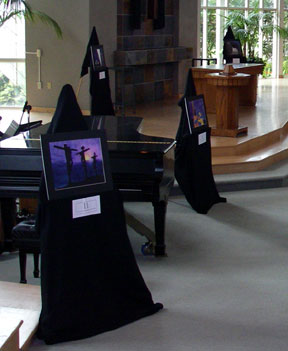Preface
My tradtion during the last few years has been to put up a special Lent and Holy Week devotional series as we approach Good Friday and Easter. Last year I did a series called The Seven Last Words of Christ: Reflections for Holy Week. Two years ago I focused on The Stations of the Cross. This year I will revisit that topic. Some of my posts will be edited versions of what I’ve written before; some may be new. My point is not to impress you with my novelty, but rather to help you focus on the deeper meaning of Jesus’ suffering and death.
Once again, I will be using a new version of The Stations of the Cross that is based completely on biblical passages. I’ll explain further in the following introduction.
Introduction
I first became aware of The Stations of the Cross while on vacation in San Francisco, California. As I visited St. Mary’s Cathedral, I noticed around the nave of the church, what we Protestants would call the sanctuary, a series of visual reminders of Jesus’ last hours. These seemed to encourage the Catholic faithful in their personal devotion. I did not at the time realize the irony of my discovering The Stations of the Cross in San Francisco, a city named after St. Francis of Assisi, the Catholic saint whose order had much to do with the development of devotion associated with The Stations of the Cross. Nor did I realize back then that virtually every Catholic church uses some form of The Stations of the Cross.
I became more familiar with The Stations of the Cross, also known as The Way of the Cross, or Via Crucis (Latin, “way of the cross”) or Via Dolorosa (Latin, “way of grief”), when I began going on retreats at Catholic retreat centers. All of these places for prayer featured a series of scenes that depict the passion of Christ. Often, I saw people slowly walking along The Stations of the Cross, pausing at each station for quiet meditation and prayer.
 A few years ago I decided to follow The Way of the Cross at the Serra Retreat Center in Malibu, California. Whereas most Catholic churches include the stations within the church building, the Serra stations were outside in an aromatic grove of Eucalyptus trees. As I walked The Way of the Cross that day, I found myself reflecting with more intensity and emotion upon the events of Jesus’s death. (Photo: Some of the stations at the Serra Retreat Center. The one to the right is #6, Veronica Wipes the Face of Jesus.)
A few years ago I decided to follow The Way of the Cross at the Serra Retreat Center in Malibu, California. Whereas most Catholic churches include the stations within the church building, the Serra stations were outside in an aromatic grove of Eucalyptus trees. As I walked The Way of the Cross that day, I found myself reflecting with more intensity and emotion upon the events of Jesus’s death. (Photo: Some of the stations at the Serra Retreat Center. The one to the right is #6, Veronica Wipes the Face of Jesus.)
In 2003, millions of people became familiar with the traditional Stations of the Cross without knowing it. These stations provided the structure for Mel Gibson’s blockbuster film, The Passion of the Christ. Little did many of us know that as Jesus fell three times while carrying his cross in the movie, or as he met his mother, that he was doing that which Roman Catholic tradition had popularized for centuries through The Stations of the Cross.
The origin of this tradition is not entirely clear, though it seems to be associated with Christian pilgrimages to Jerusalem in the early Christian centuries. (For a detailed online history, see “The Way of the Cross” in The Catholic Encyclopedia.) Yet, since the vast majority of Christians were not able to go to Jerusalem to pray in the actual location where Jesus was crucified, The Way of the Cross enabled them to engage in a mini-pilgrimmage of sorts, whereby they could focus on the key events of Jesus’ last day.
In the Middle Ages, this practice got wrapped up with the granting of indulgences (remissions of temporal punishments for sins for which we have been forgiven). The whole indulgence scene became quite messy, and was in fact one of the major reasons for the Protestant Reformation. Thus it’s not surprising that Protestants didn’t maintain the tradition of walking The Way of the Cross as an act of devotion.
When I first followed The Stations of the Cross, I related readily to about half of the scenes. But the other half seemed odd to me because the statues depicted unfamiliar events, including: three falls of Jesus, an encounter between Jesus and his Mother, and an encounter between Jesus and a woman named Veronica. These stations were not derived directly from Scripture, but rather from ancient church tradition. Though I wasn’t offended by the traditional nature of the unfamiliar scenes, since they were in no way contrary to Scripture, I found myself more drawn to the seven stations that were clearly based on the biblical record. I am, after all, a Protestant at heart, one for whom tradition can be helpful, but Scripture is the main source of my spiritual devotion.
Well, as it turns out, Pope John Paul II seems to have shared my concern about the lack of biblical foundation for the traditional Stations of the Cross, though he often celebrated these without hesitation. He was, after all, a Roman Catholic at heart. Yet in 1991 the Pope himself instituted a new series of fourteen Stations of Cross, each of which was based on Scripture alone. The chart below shows both the traditional and the revised stations, with Scripture references. (Note: These Scripture references come from the 2004 version of the Pope’s
Stations of the Cross. The 1991 version had the same basic headings,
but some different biblical texts.)
Traditional
Biblical
1. Jesus on the Mount of Olives(Luke 22:39-46) 2. Jesus, betrayed by Judas, is arrested (Luke 22:47-48) 3. Jesus is condemned by the Sanhedrin (Luke 22:66-71) 4. Peter denies Jesus (Luke 22:54-62) 1. Jesus is condemned to death 5. Jesus is judged by Pilate(Luke 23:13-25) 6. Jesus is scourged and crowned with thorns (Luke 22:63-65; John 19:2-3) 2. Jesus takes up his cross 7. Jesus takes up the cross(Mark 15:20) 3. Jesus falls for the first time 4. Jesus meets his mother 5. Jesus is helped by Simon the Cyrene to carry his cross 8. Simon of Cyrene helps Jesus to carry his cross (Luke 23:26) 6. Veronica wipes the face of Jesus 7. Jesus falls for the second time 8. Jesus meets the women of Jerusalem 9. Jesus meets the women of Jerusalem(Luke 23:27-31) 9. Jesus falls for the third time 10. Jesus is stripped of his garments 11. Jesus is nailed to the cross 10. Jesus is crucified (Luke 23:33, 47) 11. Jesus promises his Kingdom to the good thief (Luke 23:33-34, 39-43) 12. Jesus on the cross, his mother and his disciple (John 19:25-27) 12. Jesus dies on the cross 13. Jesus dies on the cross(Luke 23:44-46) 13. Jesus is taken down from the cross and given to his mother 14. Jesus is laid in the tomb 14. Jesus is placed in the tomb(Luke 23:50-54)
 In 2006, some people at Irvine Presbyterian Church, where I served as Senior Pastor, decided to offer The Stations of the Cross as a devotional experience for Holy Week. For obvious reasons, we opted for the Pope’s biblically-based version. My wife, Linda, offered to paint fourteen watercolor pictures that illustrated the passages upon which the revised stations are based. These were displayed in our church sanctuary during Holy Week. People were invited to come, to read Scripture, to reflect, and to pray. For many members of my church and community, it was a precious time of drawing near to the Lord in anticipation of Good Friday and Easter. (Photo: Four of the stations in the Irvine Presbyterian Church sanctuary a couple of years ago.)
In 2006, some people at Irvine Presbyterian Church, where I served as Senior Pastor, decided to offer The Stations of the Cross as a devotional experience for Holy Week. For obvious reasons, we opted for the Pope’s biblically-based version. My wife, Linda, offered to paint fourteen watercolor pictures that illustrated the passages upon which the revised stations are based. These were displayed in our church sanctuary during Holy Week. People were invited to come, to read Scripture, to reflect, and to pray. For many members of my church and community, it was a precious time of drawing near to the Lord in anticipation of Good Friday and Easter. (Photo: Four of the stations in the Irvine Presbyterian Church sanctuary a couple of years ago.)
Your church may be using The Stations of the Cross for Lenten and Holy Week devotions. If so, I encourage you to participate. But if you don’t have access to such a thing, I’m going to do an online version of The Stations of the Cross. Beginning tomorrow, I’ll “walk” through the stations with you, one station per day. At this pace we’ll complete the fourteen stations on Holy Saturday (which will feature the last of the stations). I’ll include the Scripture passages for each station, some personal reflections and prayers, and photographs of my wife’s paintings. My hope is that this online version of The Way of the Cross will enable you to enter into a deeper understanding and experience of the passion of Jesus, so that you might be ready to celebrate Easter with new joy and freedom.
P.S. If you would like to use any of this material for your church, you are welcome to it. In a couple of days I’ll put up a link to the whole series. If you would like higher resolution versions of Linda’s paintings, please email me.

